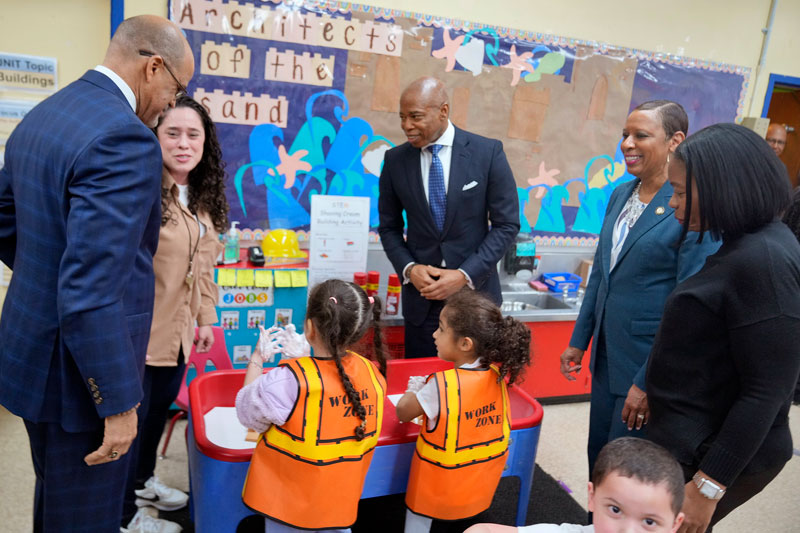Mayor Adams, Speaker Adams Protect Over $500 Million in key Education Programs
Mayor Adams, Speaker Adams Protect Over $500 Million in key Education Programs nyc.gov


City Funds More Than $500 Million in Department of Education Programming
April 19, 2024

Watch the video here at https://www.youtube.com/watch?v=ImBUSxYm-5Y
[embedded content]
City Funds More Than $500 Million in Department of Education Programming Previously Supported with Temporary Stimulus Funds, Bolstering Mental Health Care, Career Readiness, and Literacy Support
$5 Million Effort Will Maximize Enrollment in 3-K and Pre-K Programs Across New York City
City Invests $25 Million for Pre-K Students with Special Needs
Adams Administration Adds $8 Million for Ongoing Implementations of MyCity Portal, Making it Easier for New Yorkers to Apply for Subsidized Child Care
New York City Mayor Eric Adams and New York City Council Speaker Adrienne Adams announced that the city will make multiple new investments, including more than $500 million in city and state funding for educational programs for young New Yorkers in Mayor Adams’ Executive Budget next week. The investments are aligned with the Sustainable Development Goals (SDGs) and will contribute to the achievement of several SDGs, including Quality Education (SDG 4), Good Health and Well-being (SDG 3), Decent Work and Economic Growth (SDG 8), and Reduced Inequalities (SDG 10).
Protecting Education Programs
The city will protect $514 million in New York City Department of Education (DOE) programs that were previously supported with temporary stimulus funds. The majority of this funding will be baselined with recurring dollars, ensuring the sustainability of these programs. The protected programs include mental health care, career readiness, and literacy programs for New York City public school students in the Fiscal Year 2025 (FY25) Executive Budget.
Maximizing Enrollment in Early Childhood Education
The Adams administration will launch a $5 million outreach effort to maximize the number of children enrolled in 3-K and Pre-K programs across New York City. This investment aims to address the issue of tens of thousands of empty early childhood education seats that remain unfilled every day. By focusing on populations and neighborhoods with low enrollment rates, the administration aims to ensure that every child who needs an early childhood education seat can access one.
Supporting Pre-K Students with Special Needs
The city will invest $25 million in funding to provide special education classes and related services within district schools to Pre-K students with special needs who would otherwise be on waiting lists at contracted providers. This investment will ensure that these students receive the necessary support and resources for their education.
Easier Access to Subsidized Child Care
The Adams administration will invest $8 million toward the MyCity portal, making it easier for any New Yorker to apply for subsidized child care and other city services. The MyCity portal serves as a one-stop-shop where parents can easily apply for and track their applications for subsidized child care. This investment aims to improve access to affordable child care for working-class families.
Quotes from Officials
Mayor Adams stated, “Nobody works harder than New York City parents and families, and we know that nothing holds them back more than the lack of access to child care and support for their kids. Our administration has invested in our children, increasing public school enrollment, boosting test scores, and revolutionizing how we are teaching kids to read, and today we’re delivering again for working-class families.”
Speaker Adams said, “Our students, especially those who require critical support services, need continued access to the programs that can help them recover from historic pandemic-era learning losses. The Council has consistently called for funding commitments to these vital initiatives that were at risk. We are encouraged by this significant step and look forward to our continued work with the administration and all stakeholders to deliver a budget that supports essential services for New Yorkers.”
Investments in Education Programs
The Adams administration will allocate the $514 million in city resources and recurring state funds to backfill various DOE programs, including:
- Supporting the citywide 3-K expansion
- Supporting mental health supports in schools
- Maintaining funding for special education Pre-K providers
- Funding for Community Schools
- Supporting career pathways programs in high schools
- Providing arts funding programming
- Funding for Learn to Work programs
- Supporting the Public Schools Athletic League
- Investing in literacy and dyslexia programs
- Funding for coordinators for students in temporary housing
- Supporting bilingual education programs
- Providing programming through community-based organizations
- Funding for nonprofit affinity groups
- Supporting the New Visions Data Platform data portal
- Investing in translation and interpretation services
Expanding Enrollment Efforts
The administration will invest $5 million to expand enrollment efforts and raise awareness of 3-K and Pre-K opportunities across the five boroughs. This investment aims to maximize the usage of these high-quality early childhood education programs and provide support to parents struggling with costly child care.
Previous Investments and Policies
Under Mayor Adams’ leadership, the city has made significant investments and enacted policies to support working-class families and improve access to affordable child care. These include reducing the per child co-payment or out-of-pocket cost of subsidized child care, increasing the number of children enrolled in child care, and launching the MyCity portal for easy application and tracking of subsidized child care.
By prioritizing education and child care, the Adams administration is working towards achieving the Sustainable Development Goals and ensuring a brighter future for all New Yorkers.
SDGs, Targets, and Indicators
1. Which SDGs are addressed or connected to the issues highlighted in the article?
- SDG 4: Quality Education
- SDG 8: Decent Work and Economic Growth
- SDG 10: Reduced Inequalities
2. What specific targets under those SDGs can be identified based on the article’s content?
- SDG 4.1: By 2030, ensure that all girls and boys complete free, equitable, and quality primary and secondary education leading to relevant and effective learning outcomes.
- SDG 4.2: By 2030, ensure that all girls and boys have access to quality early childhood development, care, and pre-primary education so that they are ready for primary education.
- SDG 4.5: By 2030, eliminate gender disparities in education and ensure equal access to all levels of education and vocational training for the vulnerable, including persons with disabilities, indigenous peoples, and children in vulnerable situations.
- SDG 8.5: By 2030, achieve full and productive employment and decent work for all women and men, including for young people and persons with disabilities, and equal pay for work of equal value.
- SDG 10.2: By 2030, empower and promote the social, economic, and political inclusion of all, irrespective of age, sex, disability, race, ethnicity, origin, religion, or economic or other status.
3. Are there any indicators mentioned or implied in the article that can be used to measure progress towards the identified targets?
Yes, the article mentions several indicators that can be used to measure progress towards the identified targets:
- Number of children enrolled in 3-K and Pre-K programs
- Amount of funding allocated for special education classes and related services within district schools for Pre-K students with special needs
- Amount of funding invested in the MyCity portal to make it easier for New Yorkers to apply for subsidized child care and other city services
- Number of social workers and psychologists providing mental health supports in schools
- Number of community schools supported with funding
- Number of students participating in career pathways programs in high schools
- Amount of funding allocated for arts programming in schools
- Number of students benefiting from literacy and dyslexia programs
- Number of coordinators for students in temporary housing in schools and shelters
- Number of bilingual education programs supported with funding
- Number of schools using the New Visions Data Platform data portal
- Number of translation and interpretation services provided for DOE students and families
Table: SDGs, Targets, and Indicators
| SDGs | Targets | Indicators |
|---|---|---|
| SDG 4: Quality Education | 4.1 By 2030, ensure that all girls and boys complete free, equitable, and quality primary and secondary education leading to relevant and effective learning outcomes. | – Number of children enrolled in 3-K and Pre-K programs – Amount of funding allocated for special education classes and related services within district schools for Pre-K students with special needs – Amount of funding invested in the MyCity portal to make it easier for New Yorkers to apply for subsidized child care and other city services |
| SDG 8: Decent Work and Economic Growth | 8.5 By 2030, achieve full and productive employment and decent work for all women and men, including for young people and persons with disabilities, and equal pay for work of equal value. | – Number of social workers and psychologists providing mental health supports in schools – Number of community schools supported with funding – Number of students participating in career pathways programs in high schools – Amount of funding allocated for arts programming in schools – Number of students benefiting from literacy and dyslexia programs |
| SDG 10: Reduced Inequalities | 10.2 By 2030, empower and promote the social, economic, and political inclusion of all, irrespective of age, sex, disability, race, ethnicity, origin, religion, or economic or other status. | – Number of coordinators for students in temporary housing in schools and shelters – Number of bilingual education programs supported with funding – Number of schools using the New Visions Data Platform data portal – Number of translation and interpretation services provided for DOE students and families |
Behold! This splendid article springs forth from the wellspring of knowledge, shaped by a wondrous proprietary AI technology that delved into a vast ocean of data, illuminating the path towards the Sustainable Development Goals. Remember that all rights are reserved by SDG Investors LLC, empowering us to champion progress together.
Source: nyc.gov

Join us, as fellow seekers of change, on a transformative journey at https://sdgtalks.ai/welcome, where you can become a member and actively contribute to shaping a brighter future.







